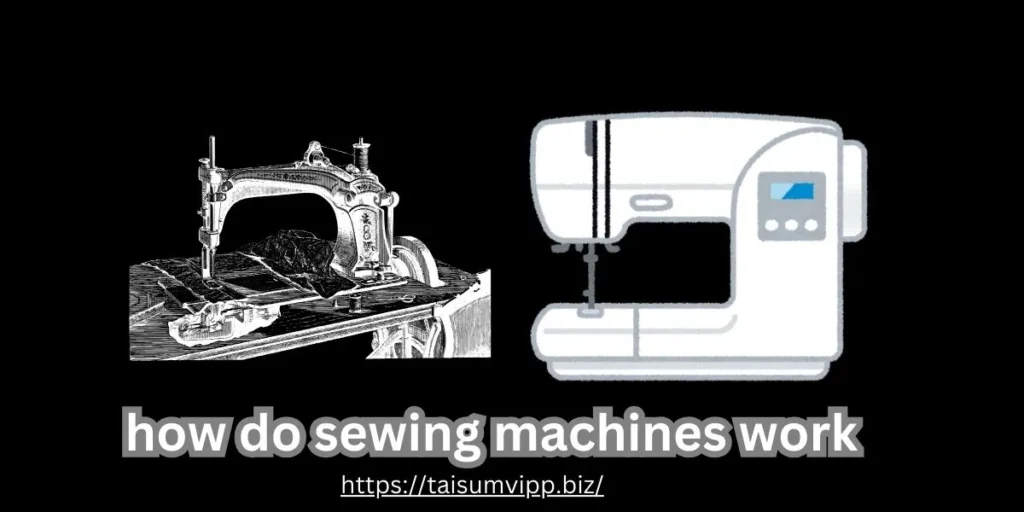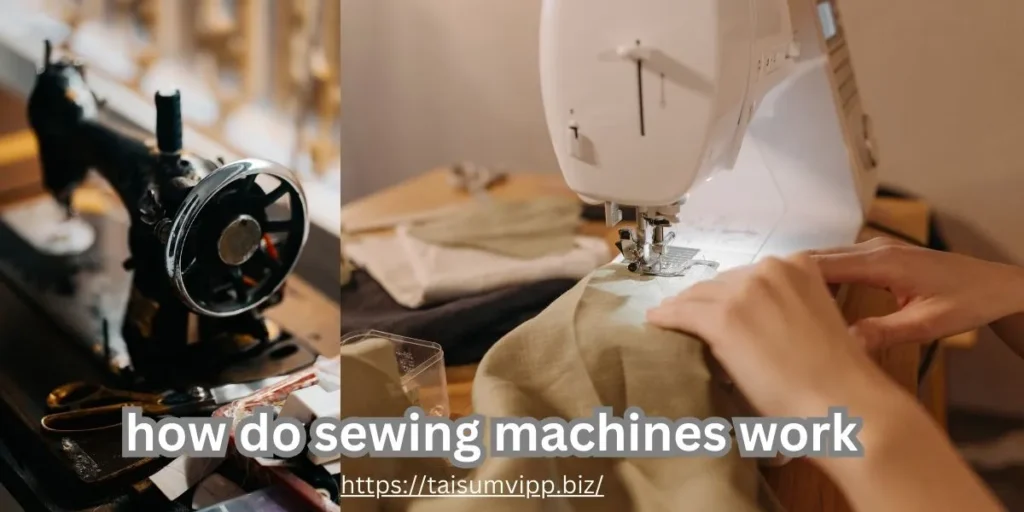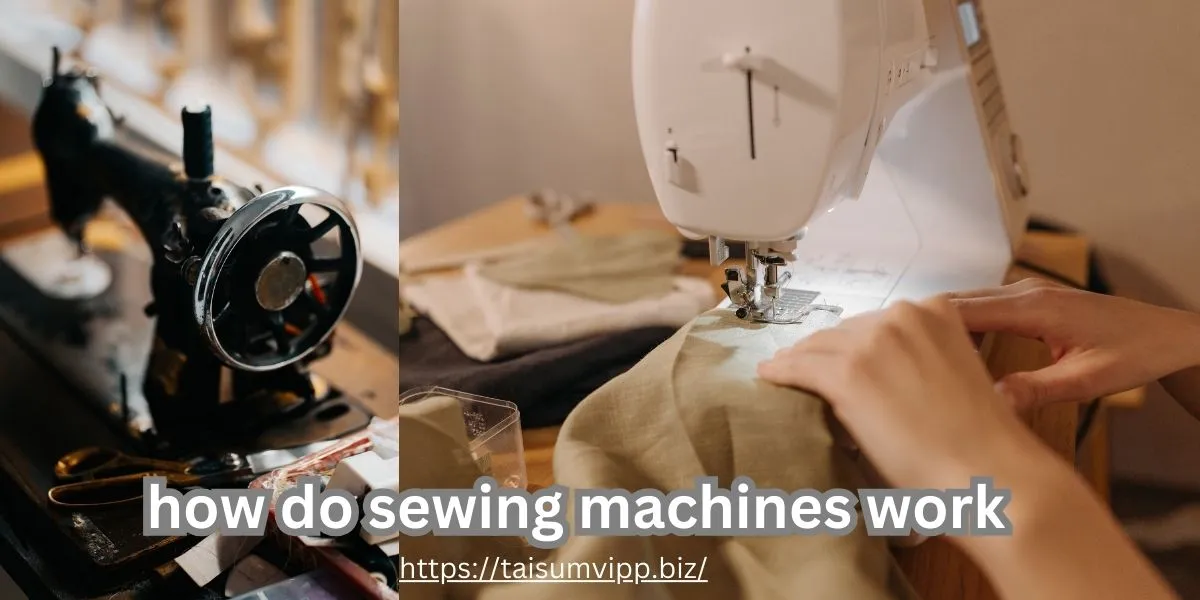Sewing machines have revolutionized the way we create and mend clothes. These ingenious inventions have simplified the task of stitching fabrics together, making it faster and more efficient. But have you ever wondered how sewing machines actually work? In this article, we will explore the inner workings of sewing machines and unveil the magic behind their operation. So, let’s dive in and discover the fascinating world of sewing machines.
How do sewing machines work step by step
To understand how sewing machines work, let’s break down the process step by step. First, a sewing machine starts with a needle, which is connected to a thread. As you guide the fabric through the machine, the needle moves up and down, making a series of precise loops with the thread. These loops interlock with each other, creating a strong and secure stitch.

The needle is powered by a mechanism known as the sewing machine’s motor. This motor provides the necessary energy to move the needle rapidly, allowing it to penetrate the fabric and create the loops. It’s impressive to think that all this intricate movement happens within a matter of milliseconds.
How do sewing machines work for beginners
If you’re new to sewing machines, don’t worry! They may seem complex at first glance, but with a little practice and understanding, you’ll be stitching away in no time. One of the key components to familiarize yourself with is the sewing machine’s foot pedal. By pressing on the pedal, you control the speed at which the needle goes up and down. Start slow and gradually increase your speed as you gain confidence in your sewing abilities.
Another essential feature for beginners is the tension control. This allows you to adjust the tightness of the stitch, ensuring that it is secure without damaging the fabric. Experiment with different tension settings until you find the perfect balance for your desired outcome.
How does a sewing machine work in words
In simple terms, a sewing machine works by creating a repeated motion of the needle and thread. As the needle pierces the fabric, it carries the thread through, forming a loop. The shuttle mechanism then catches the loop, pulling the thread’s end through the fabric. This process is repeated continuously, creating a line of stitches along the fabric.
When the thread loops are secured, they prevent the fabric from unraveling and hold the pieces together. By adjusting the machine’s settings, you can control the stitch length, width, and even create decorative patterns, expanding your creative possibilities.
How did the sewing machine work in 1846
The needle and shuttle mechanism used in early sewing machines, such as the one invented by Elias Howe in 1846, followed a similar principle to modern machines. Howe’s machine featured a lockstitch mechanism, which allowed for a stronger and more durable stitch than previous methods. The machine was powered by a foot pedal, and the operator guided the fabric through the machine while adjusting the tension and stitch length manually.
In comparison to today’s sewing machines, the early versions were simpler in design but still accomplished the fundamental task of stitching fabrics together. Their impact was immense, enabling greater productivity and transforming the textile industry forever.
How do sewing machines work animation
For a visual representation of how sewing machines work, animations are an excellent resource. They demonstrate the intricate movements of the needle, thread, and shuttle mechanism in action. With these animations, you can witness the fascinating process unfold right before your eyes, giving you a clearer understanding of how each component contributes to creating a perfect stitch.
By watching these animations, you can also grasp the importance of proper thread tension, correct needle positioning, and smooth fabric feeding. These factors influence the quality of the stitch and can make a considerable difference in the final outcome of your sewing projects.
How do computerized sewing machines work
Advancements in technology have brought us computerized sewing machines, which offer a whole new level of precision and convenience. These machines rely on computer technology to control various aspects of the sewing process. By inputting your desired stitch patterns or settings into the machine’s interface, it can automatically adjust the needle position, tension, and feed rate to achieve your desired result.
Computerized sewing machines also provide an array of built-in stitches, allowing you to explore creative possibilities beyond the standard straight stitch. With the touch of a button, you can effortlessly switch between different stitch options, decorative patterns, and even embroidery designs. These machines have truly revolutionized the sewing experience, making it more accessible and enjoyable for individuals of all skill levels.
How does the sewing machine work during the industrial revolution
The invention of the sewing machine played a pivotal role during the industrial revolution. Before sewing machines, clothing production was a labor-intensive process, limited by the speed and skill of hand-sewing. However, the introduction of sewing machines allowed for increased productivity, transforming the textile industry.
During the industrial revolution, sewing machines were powered by steam or foot pedals and operated in factories by skilled workers. The machines greatly expedited the stitching process, enabling mass production and reducing the cost of clothing. This breakthrough revolutionized the way garments were manufactured, making them more affordable and accessible to a broader population.
How did the sewing machine function?
The sewing machine functions through a combination of mechanical components and techniques. As mentioned earlier, the needle moves up and down rapidly, creating a series of loops with the thread. These loops are then secured by a combination of tension, stitch length, and directionality, depending on the desired stitch pattern.
Additionally, sewing machines often incorporate a bobbin, which holds a separate thread to form the underside of the stitch. The combination of the top thread and the bobbin thread intertwines to create a locked stitch, ensuring the longevity and durability of the sewn pieces.
How does a sewing machine sew clothes?
Sewing machines are indispensable tools for creating garments. Whether it be sewing a simple hem, attaching buttons, or constructing an entire wardrobe, sewing machines simplify the process and make it more efficient. The combination of different stitches, adjustable tension, and variable stitch length allows you to tailor the sewing machine’s settings to accommodate various fabric types and project requirements.
When sewing clothes, it is crucial to align the fabric pieces accurately before feeding them into the machine. By holding the fabric steadily and guiding it through the machine’s feed dog mechanism, you can ensure even stitching and avoid bunching or puckering. Regular cleaning and maintenance of the sewing machine also ensure smooth operation and optimal performance.
What are the 4 types of sewing?
Sewing encompasses a broad range of techniques and styles, catering to diverse project needs. Let’s explore the four main types of sewing:
- Hand sewing: This traditional method relies on a needle and thread, allowing for intricate and precise stitching by hand. Hand sewing is commonly used for delicate fabrics, repairs, or detailed embellishments.
- Machine sewing: As discussed earlier, machine sewing involves using a sewing machine to stitch fabric quickly and efficiently. This method is ideal for larger projects or when time is of the essence.
- Embroidery: Embroidery adds decorative patterns and designs to fabric by hand or machine. It brings a unique and personal touch to garments, home decor items, and accessories.
- Serger sewing: A serger, also known as an overlocker, is a specialized machine that trims the fabric edge while simultaneously stitching it, creating a neat and professional finish. Sergers are commonly used for hemming, seaming, and creating decorative edges.
Each type of sewing offers its own advantages and techniques, giving you the flexibility to tackle a wide range of sewing projects.
What is a sewing tool?
A sewing tool refers to any instrument or accessory that assists in the sewing process. These tools are designed to make sewing easier, more precise, and efficient. Whether you’re a beginner or an experienced seamstress, having the right sewing tools can greatly enhance your sewing experience.
Some common sewing tools include:
- Scissors: Sharp fabric scissors ensure clean cuts and prevent fraying edges.
- Pins and needles: These essentials keep fabric pieces in place during sewing and facilitate precise stitching.
- Seam ripper: When mistakes happen, a seam ripper helps remove incorrect stitches without damaging the fabric.
- Measuring tape: Accurate measurements are crucial for achieving proper fit and dimensions in your sewing projects.
- Thread spools and bobbins: These hold the thread used in the sewing machine for seamless stitching.
These are just a few examples of sewing tools, but the list goes on, catering to different sewing needs and preferences.
What is a good sewing machine?
Choosing the right sewing machine can significantly impact your sewing experience and the quality of your projects. Here are a few things to consider when looking for a good sewing machine:
- Type and features: Determine your sewing needs and select a machine that offers the features required for your projects. Consider whether you want a basic machine for everyday use or a more advanced one for specialized techniques.
- Quality and durability: Look for a sewing machine made from high-quality materials and built to withstand consistent use over time. Reading reviews and seeking recommendations can help gauge a machine’s reliability.
- Price range: Set a budget and explore sewing machines within that range. While expensive machines often offer more advanced features, there are also affordable options that deliver excellent performance.
- Brand reputation: Research different sewing machine brands and the reputation they hold for producing reliable and user-friendly products. Established brands often have a wide range of options to choose from.
Remember that the best sewing machine for you ultimately depends on your sewing goals, skill level, and personal preferences.
The Role of Needles and Thread in Sewing Machines
Needles and thread are two essential components in sewing machines that directly influence stitch quality and outcome. Let’s take a closer look at their roles:
Needles: Sewing machine needles come in various sizes and types, designed to accommodate different fabric weights and thread thicknesses. Selecting the appropriate needle ensures smooth fabric penetration and minimizes the risk of needle breakage or skipped stitches. It’s important to replace needles regularly, as dull or damaged needles can cause fabric damage or irregular stitching.
Thread: The choice of thread can impact the durability and aesthetics of your projects. Different threads are suitable for various fabrics and sewing techniques. Polyester and cotton threads are common options and offer strength and versatility. It’s crucial to ensure the thread is properly threaded through the machine’s tension discs, as incorrect threading can lead to uneven or loose stitches.
By paying attention to needle selection and using quality thread, you can achieve professional-looking results with your sewing machine.

Tips and Tricks for Using a Sewing Machine Effectively
Here are some useful tips and tricks to optimize your sewing machine experience:
- Read the manual: Familiarize yourself with your sewing machine’s specific features and settings by reading the instruction manual. This will help you understand how to properly thread the machine, change presser feet, and utilize different functions.
- Practice on scrap fabric: Before working on your actual project, practice stitching on scrap fabric to get comfortable with the machine’s speed, tension, and stitch options. This allows you to make any necessary adjustments without risking damaging your project.
- Press fabric before sewing: Ironing your fabric prior to sewing helps remove wrinkles and ensures a smooth sewing surface. It also aids in achieving precise measurements and seam allowances.
- Clean and maintain your machine: Regularly clean and oil your sewing machine to keep it running smoothly. This helps prevent lint accumulation and ensures optimal performance.
- Experiment and have fun: Don’t be afraid to explore different stitches, techniques, or creative patterns with your sewing machine. Sewing should be an enjoyable and creative process, so let your imagination run wild!
With these tips and tricks in mind, you’ll be well-equipped to make the most of your sewing machine and create beautiful, professional-looking projects.
Conclusion
Now that you have a comprehensive understanding of how sewing machines work, you can confidently embark on your sewing journey. Whether you’re a beginner or an experienced sewist, sewing machines offer a versatile and efficient way to bring your creative ideas to life. From the basic mechanical machines to advanced computerized models, the possibilities are endless.
Remember to choose the right sewing machine for your needs, maintain it regularly, and continue learning and exploring new techniques. With practice and dedication, you’ll soon master the art of sewing and unlock a world of endless possibilities and beautiful creations.
